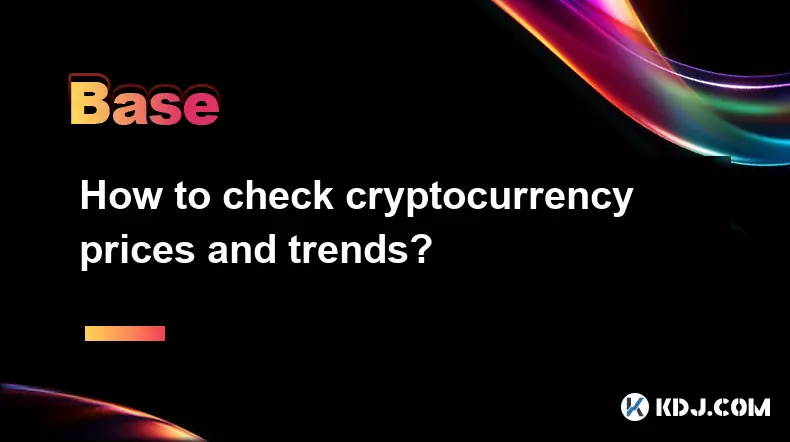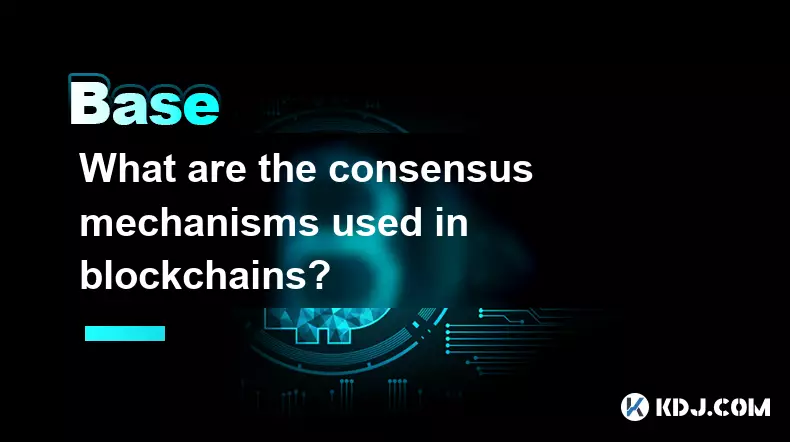-
 bitcoin
bitcoin $109523.663807 USD
-0.13% -
 ethereum
ethereum $4019.526508 USD
2.06% -
 tether
tether $1.000482 USD
0.00% -
 xrp
xrp $2.776815 USD
0.18% -
 bnb
bnb $958.942396 USD
0.12% -
 solana
solana $204.294698 USD
3.84% -
 usd-coin
usd-coin $0.999693 USD
0.00% -
 dogecoin
dogecoin $0.232115 USD
2.09% -
 tron
tron $0.338028 USD
0.84% -
 cardano
cardano $0.790920 USD
1.50% -
 hyperliquid
hyperliquid $44.871443 USD
5.60% -
 ethena-usde
ethena-usde $1.000322 USD
0.04% -
 chainlink
chainlink $21.034165 USD
2.60% -
 avalanche
avalanche $28.794831 USD
-0.54% -
 stellar
stellar $0.360466 USD
1.24%
How to check cryptocurrency prices and trends?
Crypto tracking platforms like CoinMarketCap and CoinGecko provide real-time data, price alerts, historical charts, and social sentiment to help traders analyze trends and make informed decisions.
Sep 20, 2025 at 01:36 pm

Using Cryptocurrency Tracking Platforms
1. Websites like CoinMarketCap and CoinGecko offer real-time data on thousands of cryptocurrencies, including price, market cap, trading volume, and circulating supply. These platforms allow users to sort assets by performance, category, or blockchain.
2. Users can set up price alerts that notify them when a cryptocurrency reaches a specific value. This feature helps traders react quickly to market movements without constantly monitoring charts.
3. Detailed historical price charts with customizable timeframes—ranging from hourly to yearly views—are available. These charts often include technical indicators such as moving averages and RSI for deeper analysis.
4. The platforms also provide information about exchanges where each coin is listed, enabling users to compare prices across different markets and identify arbitrage opportunities.
5. Community metrics like social sentiment, developer activity, and project updates are integrated into many tracking sites, offering insights beyond raw price data.
Analyzing Price Trends with Technical Tools
1. Traders frequently use candlestick charts to interpret market psychology. Each candle represents opening, closing, high, and low prices within a set period, revealing patterns like doji, engulfing, or hammer formations.
2. Moving averages help smooth out price data over time, making it easier to identify the direction of a trend. When a short-term average crosses above a long-term one, it may signal upward momentum.
3. Volume analysis is critical; rising prices accompanied by increasing trading volume suggest strong buyer interest, while price increases on low volume may indicate a weak rally.
4. Indicators like MACD (Moving Average Convergence Divergence) and Bollinger Bands assist in determining whether an asset is overbought or oversold, guiding entry and exit decisions.
5. Chart patterns such as triangles, head and shoulders, or double tops are studied to anticipate potential breakouts or reversals based on historical behavior.
Leveraging Social and News Feeds
1. Crypto-specific news outlets like Cointelegraph and The Block deliver breaking updates on regulations, exchange listings, and technological upgrades that impact prices.
2. Social media platforms, especially Twitter and Reddit, serve as hubs for sentiment analysis. Sudden spikes in mentions or bullish language around a coin can precede price movements.
3. Telegram and Discord channels linked to specific projects often share development milestones or partnership announcements before they appear on mainstream platforms.
4. Influencers and analysts post chart interpretations and price predictions, which can influence retail investor behavior and contribute to short-term volatility.
5. Monitoring Google Trends for search volume related to a cryptocurrency provides insight into growing public interest, often correlating with price surges.
Frequently Asked Questions
How often are cryptocurrency prices updated on tracking sites?Prices are typically refreshed every few seconds, depending on the data source and platform infrastructure. Major sites pull live feeds directly from exchanges to ensure minimal delay.
Can I rely solely on price charts to make investment decisions?Charts provide valuable context but should be combined with fundamental analysis. Factors like team credibility, tokenomics, and real-world adoption play crucial roles in long-term viability.
What causes sudden price spikes in low-cap cryptocurrencies?Low-market-cap coins are more susceptible to manipulation and rapid shifts due to limited liquidity. A single large buy order or coordinated social media campaign can trigger sharp upward movements.
Is historical price data accurate across all tracking platforms?Most reputable platforms maintain consistent historical records, though discrepancies may occur during extreme volatility or if an exchange reports delayed or incorrect trade data.
Disclaimer:info@kdj.com
The information provided is not trading advice. kdj.com does not assume any responsibility for any investments made based on the information provided in this article. Cryptocurrencies are highly volatile and it is highly recommended that you invest with caution after thorough research!
If you believe that the content used on this website infringes your copyright, please contact us immediately (info@kdj.com) and we will delete it promptly.
- Rare 1p Coin Could Fetch £200,000: Are You Holding a Fortune?
- 2025-09-27 12:25:13
- MAGACOIN Finance: Buzz, Risks, and the Altcoin Stampede
- 2025-09-27 12:25:13
- Crypto Wallets & Utility Tokens: What's the Hype?
- 2025-09-27 12:30:02
- Shiba Inu's Burn Rate & Crypto Payroll: A New York Perspective
- 2025-09-27 12:45:11
- Grayscale, Near Protocol, and On-Chain Innovation: A New Era for Crypto?
- 2025-09-27 12:45:11
- Punjab Govt, Centre, and the Financial Package: A Tug-of-War?
- 2025-09-27 12:30:02
Related knowledge

What are some common methods of cryptocurrency market manipulation?
Sep 27,2025 at 02:55am
Wash Trading and Its Impact on Market Perception1. Wash trading involves an individual or entity simultaneously buying and selling the same cryptocurr...

How do I read a cryptocurrency whitepaper?
Sep 27,2025 at 05:54am
Understanding the Structure of a Cryptocurrency Whitepaper1. Begin by identifying the executive summary, which outlines the project’s core vision and ...

Can I recover lost cryptocurrency?
Sep 25,2025 at 08:18am
Understanding the Nature of Cryptocurrency Loss1. Cryptocurrency operates on decentralized networks, meaning there is no central authority to reverse ...

How can I earn passive income from cryptocurrency?
Sep 23,2025 at 10:18am
Staking Cryptocurrencies for Regular Returns1. Many blockchain networks operate on a proof-of-stake (PoS) consensus mechanism, allowing users to earn ...

What are gas fees in cryptocurrency transactions?
Sep 26,2025 at 02:00am
Understanding Gas Fees in Blockchain Transactions1. Gas fees are payments made by users to compensate for the computing energy required to process and...

What are the consensus mechanisms used in blockchains?
Sep 24,2025 at 10:00am
Proof of Work and Its Role in Blockchain Security1. Proof of Work (PoW) is one of the earliest consensus mechanisms, first implemented by Bitcoin. Min...

What are some common methods of cryptocurrency market manipulation?
Sep 27,2025 at 02:55am
Wash Trading and Its Impact on Market Perception1. Wash trading involves an individual or entity simultaneously buying and selling the same cryptocurr...

How do I read a cryptocurrency whitepaper?
Sep 27,2025 at 05:54am
Understanding the Structure of a Cryptocurrency Whitepaper1. Begin by identifying the executive summary, which outlines the project’s core vision and ...

Can I recover lost cryptocurrency?
Sep 25,2025 at 08:18am
Understanding the Nature of Cryptocurrency Loss1. Cryptocurrency operates on decentralized networks, meaning there is no central authority to reverse ...

How can I earn passive income from cryptocurrency?
Sep 23,2025 at 10:18am
Staking Cryptocurrencies for Regular Returns1. Many blockchain networks operate on a proof-of-stake (PoS) consensus mechanism, allowing users to earn ...

What are gas fees in cryptocurrency transactions?
Sep 26,2025 at 02:00am
Understanding Gas Fees in Blockchain Transactions1. Gas fees are payments made by users to compensate for the computing energy required to process and...

What are the consensus mechanisms used in blockchains?
Sep 24,2025 at 10:00am
Proof of Work and Its Role in Blockchain Security1. Proof of Work (PoW) is one of the earliest consensus mechanisms, first implemented by Bitcoin. Min...
See all articles










































































